|
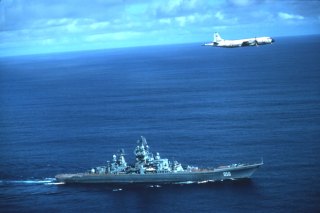
One of our P-3Bs overflying the Admiral Ushakov, the lead unit of four
nuclear-powered 24,500 ton Kirov class battlecruisers completed by the
Soviets between 1980 and 1996. Our four Iowa class battleships
were taken out of mothballs, modernized, and recommissioned between
1982 and 1988 in response to these behemoths.
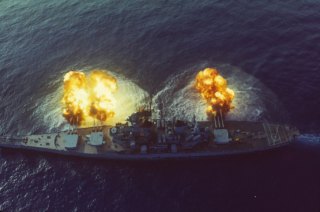
Aerial oblique view of the New Jersey firing three of her 16 inch guns
(one from each turret) simultaneously, after being recommissioned for
an unprecedented fourth time in December 1982. Every Naval officer
wanted to get a closer look at the old battleships. I was fortunate
to have actually gotten aboard the Missouri for a short stint.
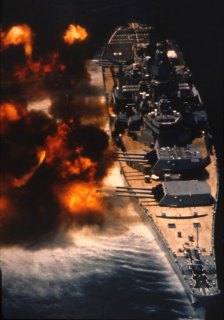
The business end of the Iowa firing three of her 16-inch rifles at targets
in a firepower demonstration for visiting dignitaries from Guatemala
in August 1984. As I recall, the Iowa had been dispatched to Guatemala
to render medical and dental assistance. Simultaneous firings
did so much vibration damage to the computers aboard ship, they began
firing one rifle at a time, with some interval between.
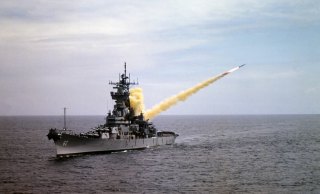
This view shows the New Jersey firing a Tomahawk cruise missile.
The Iowa class battleships were reconfigured to carry 32 Tomahawk and
16 Harpoon missiles, as well as four Phalanx CWIS gatling guns.
Three of four were decommissioned in the fall of 1991, following the
first Gulf War. The Missouri was retained for a few more months with
a reduced crew so she could attend the 50th anniversary of the Pearl
Harbor attack ceremonies in December 1991. The Missouri had hosted the
Japanese surrender in Sagami Bay near Tokyo on September 2, 1945.
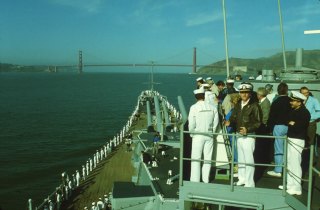
I am the officer in the leather flight jacket on the bridge of the USS
Missouri while the crew mans the rails as we depart San Francisco Bay
following the ship’s first port call in July 1987. The Missouri's
coning tower armor was 17 inches thick, making it pleasantly cool inside
during most days at sea. The belt armor protecting the hull was
over 12 inches thick and inclined at 19 degrees from vertical, to protect
the ships from armor piercing shells.
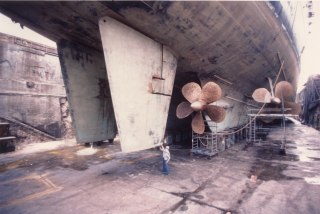
Propulsion on an Iowa Class battleship, as revealed in drydock. The
five-bladed inboard screws were 17 feet in diameter while the 4 bladed
wing screws were 18’-3” in diameter. The design power
output was 212,000 shaft horsepower (shp), with a 20% overload (up to
254,000 shp). During the New Jersey’s sea trials in December
1943 the engine room generated 221,000 shp, clocking 31.9 kts with a
displacement of 56,928 tons. The Iowas were the fastest battleships
ever built, by a wide margin. Their design speed was about 33.5
kts (38 mph), but a lightly loaded hull (51,000 tons) would have been
capable of achieving 35.4 kts (40.25 mph). That's fast enough
for waterskiing!
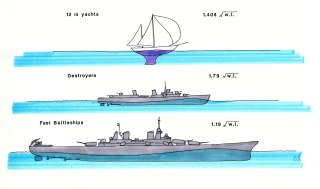
The Need for Speed. My sketch depicting the equations used to
determine the optimal waterline length for maximum speed, presenting
examples for 12 meter racing yachts (used in the America Cup races)
and World War II era destroyers and cruisers/battleships. These
values were empirically derived from model hull studies at the David
Taylor Ship Basin in Cabin John, MD in the 1930s and 40s. The length-to-beam
ratio for the Iowa Class battleships was 7.96.
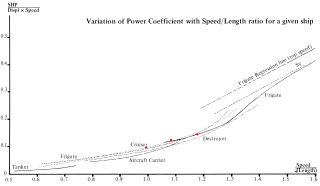
In the post World War II-era naval architects established a hydrodynamic
order or merit that eliminated the effect of displacement. The most
common comparison was this graph comparing the "power coefficient"
(shaft horsepower divided by the displacement and multiplied by the
speed) against the speed divided by the square root of length ratio.
The red dots are measured data for Iowa Class battleship sea trials. Note how these plot very close
to the line shown for cruiser hulls.
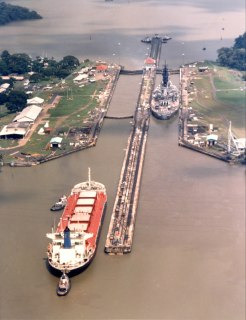
The width of the Iowa Class battleships was limited by the dimensions
of the Panama Canal locks. The maximum beam that could transit
the Canal was 108-1/6 feet because the locks are 110 feet wide. This
beam dimension was then multiplied by 7.96 to determine the waterline
length of 860 feet. This shows the battleship Iowa transiting
the Pedro Miguel Locks on June 6, 1984. Looks like a tight fit!
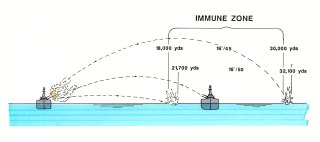
The Iowa Class battleships were designed to be immune from 18-inch armor
piercing naval gunfire at ranges between 18,000 and 30,000 yards.
Below 18,000 yards the lower trajectories of incoming shells could conceivably
pierce the inclined hull armor package.
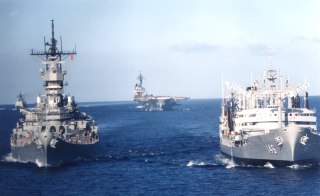
Nice shot of the Missouri positioning herself for underway refueling
from the USS Kawishiwi (AO-146), a Neosho class tanker. The carrier
Kitty Hawk is in the background, waiting her turn. This was taken
on June 25, 1986, shortly after the Missouri was recommissioned in San
Francisco (her intended homeport).
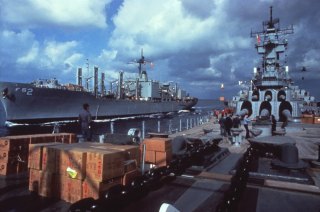
Underway replenishment between the Missouri and the stores ship USS
Sylvania (FS 2), the second unit of the Mars Class ( 576 feet long with
a displacement of 17,500 tons). The US Navy is designed for global
mobility and sustained periods at sea. This mobility is sustained
by a "invisible" fleet of stores ships and oilers that replenish
the warships every few days.
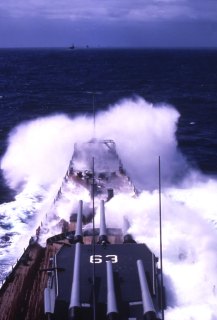
The Iowa Class battleships were the smoothest riding ships I ever rode
on, even in rough seas. This shows the forecastle of the Missouri
breaking some large waves, as viewed from the O-6 level on the bridge,
358 feet behind the bow.
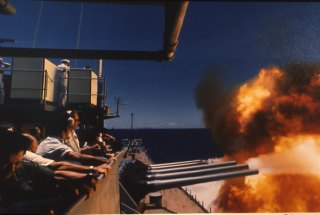
View from the O-4 level of the bridge as the 16-inch/50 caliber Mk 7
rifles of turrets one and two on Iowa are fired simultaneously.
Ear protection was essential, but no matter how much you braced yourself,
you always winced at the concussion of so much cordite detonating.
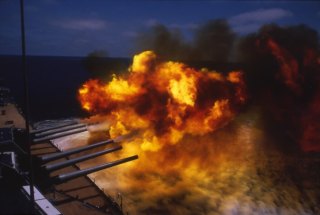
Another view taken from higher on the bridge of two other 16-inch rifles
firing on turrets 1 and 2. These are capable of hurling projectiles
weighing between 1900 and 2700 pounds 21 to 23 miles across the sea!
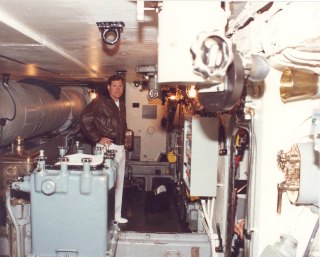
I am standing inside Turret No. 2 on the USS Missouri. The round tube
at left is the old optical (mirror) range finder, retained as a hand-operated
back-up in case the radar ever failed.
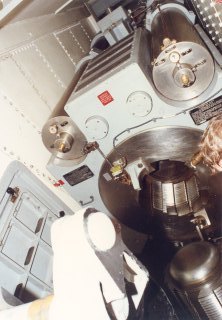
Breech of 16-inch/50 caliber rifle on the Missouri. The caliber
identifies the length of the barrel: a 50 caliber gun with a 16 inch
bore would give a barrel length of 50 times 16 inches, or 800 inches
(66.6 feet). The longer the barrel, the more accurate the trajectory
of the projectiles. The largest of the previous American battleships
had employed somewhat shorter 16-inch/45 caliber rifles.
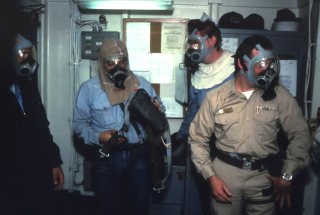
Shipboard drill using OBA’s, or Oxygen Breathing Apparatus. Every
member of the ship's crew must complete fire fighting school and know
their duties and responsibilities for different kinds of threat conditions,
such as battle stations or fire aboard ship.
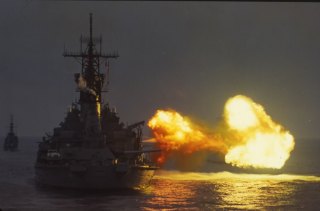
Stern view of the Missouri firing at Iraqi targets in Kuwait during
Operation Desert Storm
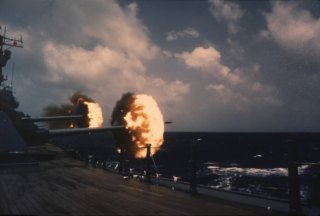
Turrets 1 and 2 firing simultaneously. Note the 16 inch projectile just
emerging from the barrel of the closest rifle! This was taken
from the forecastle (foc’sul) looking aft.
Questions
or comments on this page?
E-mail Dr. J David Rogers at rogersda@mst.edu.

|